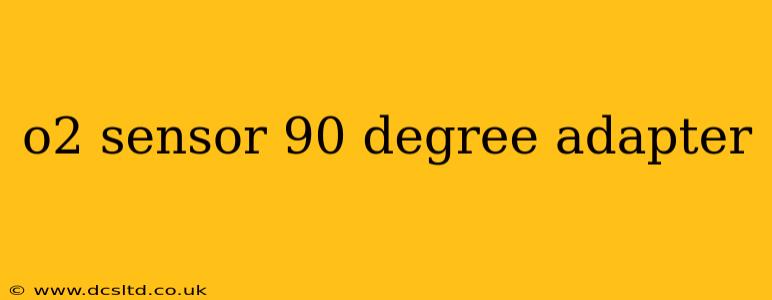Oxygen sensors are crucial components in your vehicle's emission control system, ensuring optimal engine performance and reducing harmful pollutants. Sometimes, however, the placement of the sensor presents a challenge, particularly in tight engine bays. This is where a 90-degree O2 sensor adapter comes into play. This guide explores everything you need to know about these helpful adapters, addressing common questions and concerns.
What is an O2 Sensor 90 Degree Adapter?
An O2 sensor 90-degree adapter is a simple yet vital piece of automotive hardware. It's a small connector that allows you to change the angle of your oxygen sensor by 90 degrees. This seemingly minor alteration can significantly impact installation and clearance, especially when dealing with limited space under the hood. The adapter itself is typically made of durable, heat-resistant materials like stainless steel or high-temperature alloys to withstand the harsh conditions near the exhaust manifold. It features a threaded connection on both ends to seamlessly connect to your existing sensor and exhaust system.
Why Would I Need a 90-Degree O2 Sensor Adapter?
Several scenarios necessitate the use of a 90-degree O2 sensor adapter:
- Space Constraints: The most common reason. Many modern engine bays are tightly packed, leaving little room for direct O2 sensor installation. The adapter provides the necessary clearance to avoid interference with other components.
- Exhaust Manifold Design: The design of the exhaust manifold itself might not allow for a straight-line sensor installation. The adapter corrects the angle, ensuring proper sensor placement.
- Sensor Replacement: When replacing a faulty oxygen sensor, an adapter can make the job significantly easier, particularly if access is limited.
- Custom Exhaust Systems: Aftermarket exhaust systems often require adapters to accommodate changes in pipe routing and sensor location.
What are the Different Types of O2 Sensor 90 Degree Adapters?
While the fundamental function remains consistent, several variations exist:
- Material: As mentioned, adapters are typically made from stainless steel or high-temperature alloys. The choice of material impacts durability and heat resistance.
- Thread Size: O2 sensors come in various thread sizes. Adapters must match the specific thread size of your vehicle's oxygen sensor and exhaust system. Always check your vehicle's specifications or the sensor's details before purchasing.
- Length: Adapters come in different lengths. The length is crucial to ensure proper clearance and alignment.
How Do I Install an O2 Sensor 90-Degree Adapter?
Installation is generally straightforward but requires careful attention to detail:
- Disconnect the battery: Always disconnect the battery's negative terminal before starting any work on your vehicle's electrical system.
- Remove the old sensor: Carefully remove the old oxygen sensor using the appropriate wrench. Be gentle to avoid damaging the sensor threads.
- Install the adapter: Screw the adapter onto the exhaust manifold, ensuring a secure and tight connection.
- Install the new sensor (if applicable): Screw the new oxygen sensor onto the adapter. Again, ensure a secure fit.
- Reconnect the battery: Reconnect the battery's negative terminal.
What are the Potential Problems Associated with Using an O2 Sensor 90-Degree Adapter?
While generally safe and effective, potential issues include:
- Leaks: Improper installation can lead to leaks in the exhaust system, impacting engine performance and emissions. Ensure a tight connection.
- Incorrect Thread Size: Using an adapter with the wrong thread size can damage the sensor or the exhaust system. Always double-check compatibility.
- Sensor Interference: In rare cases, the adapter might interfere with the sensor's ability to accurately read exhaust gases.
How Do I Choose the Right O2 Sensor 90-Degree Adapter for My Vehicle?
Selecting the correct adapter is paramount. Incorrect sizing can lead to installation failures and potential damage. Begin by identifying:
- Your vehicle's year, make, and model: This helps determine the correct O2 sensor thread size and location.
- Your oxygen sensor's specifications: The sensor's thread size is crucial for compatibility.
- The space available for installation: This helps determine the necessary adapter length. Consult your vehicle's repair manual or a qualified mechanic for assistance.
By carefully considering these factors and following the installation instructions diligently, you can ensure a smooth and successful installation of your 90-degree O2 sensor adapter, resolving clearance issues and maintaining your vehicle's optimal performance.
